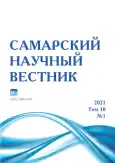Каргопольская керамика: отдельный тип или разновидность ямочно-гребенчатой керамики (на примере материалов с поселений Карелии)?
- Авторы: Герман К.Э.1, Лобанова Н.В.1
-
Учреждения:
- Институт языка, литературы и истории Карельского научного центра РАН
- Выпуск: Том 10, № 1 (2021)
- Страницы: 211-217
- Раздел: Исторические науки и археология
- URL: https://journals.rcsi.science/2309-4370/article/view/70373
- DOI: https://doi.org/10.17816/snv2021101205
- ID: 70373
Цитировать
Полный текст
Аннотация
Цель данного исследования – рассмотреть феномен каргопольской керамики на территории Карелии, который проявляется в ее ярком своеобразии, резком отличии от других типов неолитической посуды и обширности ареала – от Онежского озера на западе до реки Печора на востоке и от Южного Беломорья на севере до южных пределов Вологодской области на юге. В Карелии известно 20 поселений, в комплексах которых содержится каргопольская керамика общим числом 275 сосудов. Центром этого пласта древностей является озеро Водлозеро, расположенное у границы Карелии с Архангельской областью. Большинство каргопольских сосудов имеют прямой плоскосрезанный венчик с короткими и неглубокими насечками, нанесенными с внешнего и внутреннего края, ниже идет горизонтальный поясок сквозных ямок или наколов. Выделяются шесть вариантов орнаментации, три из которых включают элементы ямочно-гребенчатой и гребенчатой посуды. Авторами высказывается мнение, что концентрация каргопольских сосудов на памятниках восточной Карелии, главным образом в комплексах с ямочно-гребенчатой керамикой среднего этапа развития в бассейне оз. Водлозера, и почти полное ее отсутствие в других районах Карелии указывает на проникновение подобной керамической традиции с Восточного Прионежья, где она была впервые выделена. Исходя из имеющихся современных данных, пока трудно говорить о самостоятельном существовании каргопольской керамики в неолите Карелии.
Полный текст
Открыть статью на сайте журналаОб авторах
Константин Энрикович Герман
Институт языка, литературы и истории Карельского научного центра РАН
Автор, ответственный за переписку.
Email: germangermanik@yandex.ru
Кандидат исторических наук, старший научный сотрудник сектора археологии
Россия, ПетрозаводскНадежда Валентиновна Лобанова
Институт языка, литературы и истории Карельского научного центра РАН
Email: hopelob@yandex.ru
Кандидат исторических наук, старший научный сотрудник сектора археологии
Россия, ПетрозаводскСписок литературы
- Фосс М.Е. Древнейшая история Севера Европейской части СССР // Материалы и исследования по археологии СССР. № 29. М.: АН СССР, 1952. 280 с.
- Брюсов А.Я. Караваевская стоянка // Сборник по археологии Вологодской области. Вологда: Вологодское книжное издательство, 1961. С. 72–162.
- Ошибкина С.В. Неолит Восточного Прионежья. М.: Наука, 1978. 227 с.
- Ошибкина С.В. Каргопольская культура и памятники типа Модлона // Неолит Северной Евразии. М.: Наука, 1996. С. 221–228.
- Буров Г.М. Древний Синдор. М.: Наука, 1967. 220 с.
- Буров Г.М. Племена Вычегодского края в эпоху неолита и ранней бронзы // Материалы и исследования по археологии СССР. № 172. Л.: Наука, 1973. С. 83–94.
- Буров Г.М. Археологические культуры севера Европейской части СССР. Ульяновск: Ульяновский пединститут, 1974. 120 с.
- Косинская Л.Л. Керамика каргопольского (пинежско-вычегодского) типа // Археология Республики Коми. М.: ДиК, 1997. С. 168–169.
- Волокитин А.В., Карманов В.Н. Ранний неолит Европейского Северо-Востока // Российская археология. 2004. № 2. С. 5–14.
- Карманов В.Н. Неолит Европейского Северо-Востока. Сыктывкар: КомиНЦ УрО РАН, 2008. 226 с.
- Иванищева М.В. Новые данные о керамике каргопольского типа в Южном Прионежье // Ученые записки Петрозаводского государственного университета. Серия: Общественные и гуманитарные науки. 2014. № 1 (138). С. 24–28.
- Савватеев Ю.А. Неолитические поселения в низовье реки Выг // Археологические исследования в Карелии. Л.: Наука, 1972. С. 52–90.
- Косменко М.Г. Многослойные поселения Южной Карелии. Петрозаводск: КарНЦ РАН, 1992. 221 с.
- Лобанова Н.В. Культура ямочно-гребенчатой керамики // Археология Карелии. Петрозаводск: КарНЦ РАН, 1996. С. 81–104.
- Лобанова Н.В. Карельская культура ямочно-гребенчатой керамики эпохи неолита (некоторые итоги изучения) // Тверской археологический сборник. Вып. 2. Тверь: Тверской объединенный музей, 1996. С. 198–211.
- Лобанова Н.В. Каргопольская керамика на поселениях Карелии // Археология Севера. Вып. 1. Петрозаводск: Riso-Press, 1997. С. 85–95.
- Лобанова Н.В. Проблемы этнокультурной истории эпохи неолита Карелии // Проблемы этнокультурной истории населения Карелии (мезолит – средневековье). Петрозаводск: КарНЦ РАН, 2006. С. 112–137.
- Кашина Е.А., Петрова Н.Ю., Герман К.Э. К вопросу о древнейшей керамике Севера Европейской части России // Археология в музейных коллекциях: сб. мат-лов всерос. науч.-практ. конф. Архангельск: Лоция, 2019. С. 71–81.
- Кашина Е.А., Петрова Н.Ю. Керамика каргопольского типа на Севере Европейской части России в контексте современных представлений о раннем неолите лесной зоны Русской равнины // Тверской археологический сборник. Вып. 12. С. 334–344.
- Герман К.Э. Работы археологической экспедиции музея-заповедника «Кижи» в Пудожском районе Республики Карелия // Изучение и актуализация традиционной культуры (Кижский вестник, вып. 16). Петрозаводск: КарНЦ РАН, 2016. С. 274–292.
- Мельников И.В., Герман К.Э. Древние поселения южного Заонежья (мезолит – энеолит). Петрозаводск: КарНЦ РАН, 2013. 408 с.
Дополнительные файлы













